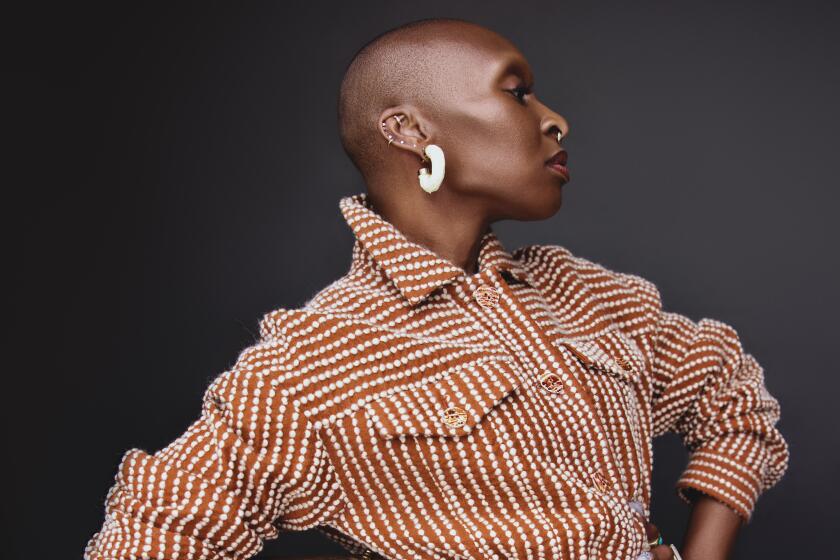A deep sense of kinship with Virginia Woolf
- Share via
In the picture, I am probably 10 years old. I’m wearing blue jeans and a bright red sweater, and I’m perched on the stump of a redwood tree, surrounded by a forest of the same. On my lap, I hold an open book. My head is bowed, long blond hair studiously tucked behind my ears. I wish I could remember the book I was reading, but I can’t.
What I do remember is that I knew my mother was taking the picture — even though she didn’t know I knew it. As a result, I was trying extra-hard to look serious. Serious summer-reading girl. That was me. Working my way on a camping trip through either the latest Cynthia Voigt coming-of-age triumph or curling my toes in terror while taking in the darkness of a Lois Duncan murder mystery.
On the other hand, at that age, I could also have been reading Anne Frank’s “The Diary of a Young Girl,” “Animal Farm,” “The Metamorphosis” or “The Catcher in the Rye,” all books my father recommended to me. I believe those were reserved for book reports that I would deliver to my fifth-grade teacher, who rewarded my precocious diligence with coupons for Pizza Hut personal pan pizzas.
I grew up in Tucson in a small, tidy home without an air conditioner or a TV. My parents were voracious readers; they read books like “The Lord of the Rings” and “Tom Sawyer” to my brother, Jason, and me before we could even walk. At night, rather than crowding around a TV set, we would spread out in our chairs in the living room and read. My parents would open the living room windows to let in the night breeze, and with it came the smell of orange blossoms and the baritone buzz of cicadas. As we got older the four of us read separate books while sitting together — our Siamese cat Jadbalja curled up in any available lap. Reading was as much a part of our daily routine as eating breakfast together.
But in the summer, reading took on a particularly heroic quality — it provided escape from the searing misery of triple-digit heat. And in August 1991, when I turned 15, it changed the person I was becoming with a revelatory flash — the first, but certainly not the last, time literature would affect me like that.
The book was “A Room of One’s Own” by Virginia Woolf. The extended essay is based on a series of lectures on women and fiction that Woolf gave in 1928 at two women’s colleges at Cambridge University. In examining the lives of female writers, Woolf concluded that for a woman to write, she needed two things that most of her contemporaries did not have: money and a room of her own. The idea led her to speculate about what would happen to a brilliant woman without resources or an outlet for her creativity. That woman could indeed be frustrated to the point of suicide, Woolf thought. The book ends with an exhortation to women to continue writing, so that one day their daughters might know true freedom of the mind.
As the daughter of a mother who went to college during the 1960s and fought the feminist battle for me, I had grown up with the feeling that I really could be anything I wanted to be. It never occurred to me that the world had once been unwelcoming of female achievement, even though my mother told me that when she was growing up there were two accepted career paths for women — teacher or secretary.
So, as I tiptoed into Woolf’s solitary room each day, leaving the sidewalks of Tucson radiating heat in waves and the pungent scent of dry creosote for the grassy lawns of early 20th Century Oxford, upon which Woolf, and women in general, were not allowed to tread, I began to feel something I hadn’t before.
It was a deep sense of kinship — the delicate, magical string that a good book can sew through the human experience. Pulled tight enough, that string can draw the whole of history around your shoulders to make you realize that you are not alone.
I finished the book sitting on a white wire rocker on our front porch. The day had been especially hot — nearly 110 degrees.
As I read the final chapter, a slight breeze began to ruffle the tattered paperback’s pages. And then I smelled it — the unmistakable scent of rain. A monsoon was coming.
I finished the book — kissing it as I closed it (something I still do) — and rose from my chair to look down the long, flat street. I could see rain — like an ink smudge — sweeping swiftly across the sky, and the hair on the back of my neck stood up in anticipation of the coming chill. As electric streaks of lightning began to flash on the horizon, I thought about the writer I wanted to become and the vastness of the life ahead of me. The world felt massive, and a shiver of excitement about the future ran through me. I thought of Woolf, and for a moment I felt that she was there with me.
My clothes were soaked, and my hair stuck to my face, and I began to weep, suddenly and uncontrollably — for the rain, for Woolf, for my mother, for my wide-open future. For the promise of a book that would never leave me.
Years later, when I was 28, I visited Woolf’s home at 29 Fitzroy Square in London. It was late at night, and I crept up the stairs just to touch the doorknob that she once touched. And I wept again, like a 15-year-old in a summer monsoon.
More to Read
The biggest entertainment stories
Get our big stories about Hollywood, film, television, music, arts, culture and more right in your inbox as soon as they publish.
You may occasionally receive promotional content from the Los Angeles Times.











